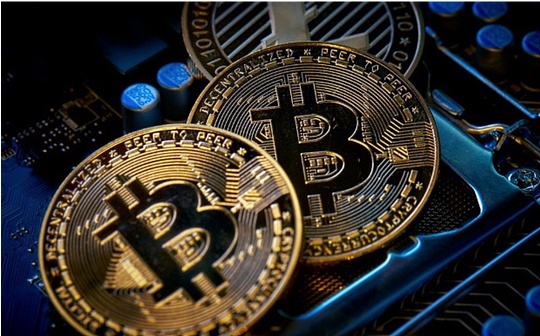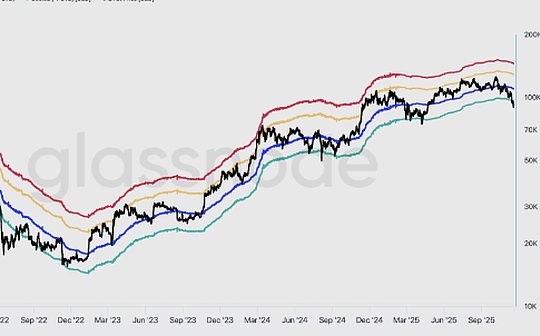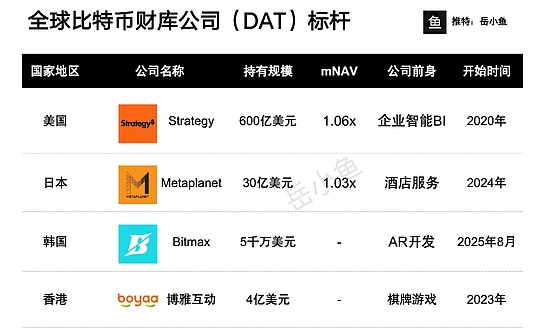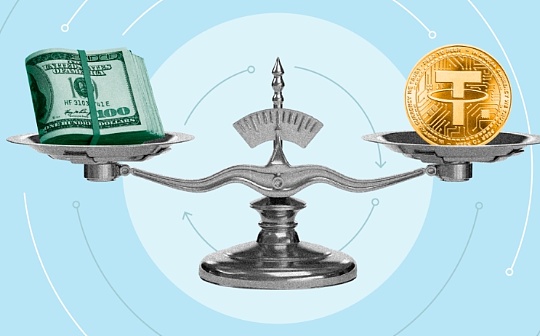
Source: Chainalysis; Compilation: Baishui, bitchain vision
Stablecoins have quietly become a powerful force in the global cryptocurrency market, accounting for more than two-thirds of the trillion-dollar cryptocurrency transactions recorded in recent months.
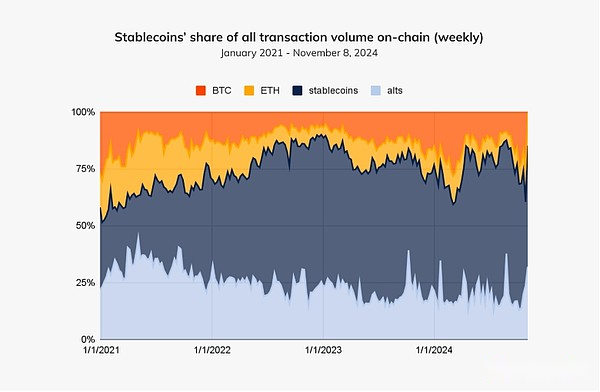
Unlike most cryptocurrencies, which often experience severe price fluctuations, stablecoins are pegged to less volatile assets (such as fiat currencies or commodities) at a 1:1 ratio to maintain consistent and predictable value.
Globally, stablecoins are developing strongly as media and means of store of value, filling the gap left by traditional currencies, especially in areas where currency instability and restricted use of the US dollar (USD).Businesses, financial institutions (FIs) and individuals are leveraging stablecoins for various use cases, from international payments to liquidity management to preventing currency fluctuations.Stablecoins can facilitate faster and more cost-effective transactions than traditional financial systems, which accelerates global adoption of stablecoins.
As the regulatory momentum around cryptocurrencies continues to grow, stablecoins are becoming the focus of discussions on technologies that shape the future of finance.
What is a stablecoin?
Stablecoins are programmable digital currencies that are usually pegged to fiat currencies such as the US dollar.Stablecoins are mainly issued on networks such as Ethereum and Tron, combining the power of blockchain technology with the financial stability required for actual use cases of cryptocurrencies.
In 2009, the introduction of Bitcoin revolutionized the world’s financial infrastructure by introducing a decentralized peer-to-peer trading system, eliminating the need for intermediaries.However, its limited supply and speculative trading dynamics have caused severe price volatility, making its native token Bitcoin (BTC) difficult to use as a medium of transactions.Similarly, when Ethereum emerged a few years later, it built on Bitcoin to extend the functionality of cryptocurrencies to programmability through smart contracts.This innovation has stimulated the rise of decentralized finance (DeFi), but like Bitcoin, Ethereum’s native token, Ethereum (ETH), has also suffered huge price volatility.
First appeared in 2014, stablecoins combine the technological advantages of blockchain such as transparency, efficiency and programmability as well as the financial stability required for widespread adoption.By addressing the issue of cryptocurrency price fluctuations, stablecoins unlock new use cases beyond trading and speculation, attracting a wide range of cryptocurrency users (including retail and institutional users).
Types of stablecoins
Stablecoins maintain their value through various mechanisms designed to ensure price stability.
Stable coins pegged to fiat currency
Stablecoins pegged to fiat currencies are by far the most popular type of stablecoins, pegged to the value of traditional currencies at 1:1, with the US dollar and the euro (EUR) being the most common benchmarks.The stability of these stablecoins stems from reserves held in fiat currencies or equivalent assets that act as collateral.Examples include the US dollar-pegged Tether (USDT) and USD Coin (USDC) and the Euro-pegged Stasis Euro (EURS).
Stable coins linked to goods
Stable coins pegged to commodities are linked to the value of physical assets such as gold, silver or other tangible commodities.These stablecoins allow users to gain commodity investment opportunities without directly owning the commodity.For example, PAX Gold (PAXG) is a stablecoin powered by a gold reserve, where each token represents a troy ounce of gold stored in a secure vault.Another example is Tether Gold (XAUT), which also provides stability backed by gold.
Cryptocurrency-backed stablecoins
Cryptocurrency-backed stablecoins are backed by reserves of other cryptocurrencies.These stablecoins usually use excess collateral (i.e., the value of assets held in the reserve is greater than the pegged value) to mitigate the inherent volatility of their underlying assets.For example, Dai (DAI) is backed by cryptocurrencies such as ETH and maintained through smart contract systems within the MakerDAO protocol.Users deposit collateral to mint Dai to ensure its stability despite volatility in collateral cryptocurrencies.
US Treasury-backed stablecoins
U.S. Treasury-backed stablecoins, such as Ondo’s USDY and Hashnote’s USYC, are different from traditional fiat-backed stablecoins backed by cash reserves or current assets.Supported by U.S. Treasury and repurchase agreements, they provide directly to holders, essentially acting as tokenized money market funds and attract investors seeking security, passive income and regulatory consistency.
Algorithm stablecoin
Algorithmic stablecoins maintain their value through a programming mechanism that adjusts supply according to market demand without relying on direct collateral.Examples of algorithmic stablecoins include Ampleforth (AMPL), which dynamically adjusts its supply to stabilize prices, and Frax (FRAX), a partially algorithmic stablecoin that combines collateral with algorithmic adjustments.Ethena’s USDe is a synthetic dollar-pegged stablecoin that uses crypto assets and automatic hedging to maintain its dollar value without having to directly hold fiat currencies.While these models are innovative, they face challenges in maintaining long-term stability, as seen in the 2022 TerraUSD (UST) collapse, highlighting the risks associated with pure algorithmic stability mechanisms.
Stable coins in the cryptocurrency market
Outside the speculation field, stablecoins play an important role in the cryptocurrency market, providing a reliable medium of transactions, a store of value, and a bridge between TradFi and cryptocurrencies.As an important liquidity provider, stablecoins support most of the activities in decentralized finance (DeFi), centralized exchanges (CEX), and cross-border payments.
As we see below, the stablecoin market has matured globally, replacing BTC as the preferred asset for daily trading.
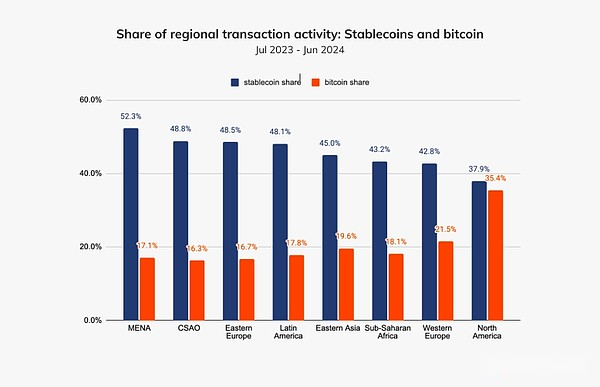
Regions such as Latin America and Sub-Saharan Africa are accepting stablecoins as a means to hedge local currency instability, providing more reliable means of trading and preservation of value.In these areas, retail investors adopt stablecoins mainly because they can be used for low-cost remittances, safe savings in areas of currency fluctuations, and access to DeFi services such as lending and pledges.
While stablecoins are becoming increasingly popular among institutions, most of their growth is driven by transfers below $1 million – which is our benchmark for non-institutional activity – which we addressed in our annual cryptocurrency geographic reportA study was conducted.Below, we examine the growth of retail and professional-scale stablecoin transfers from July 2023 to June 2024 compared with the same period last year.
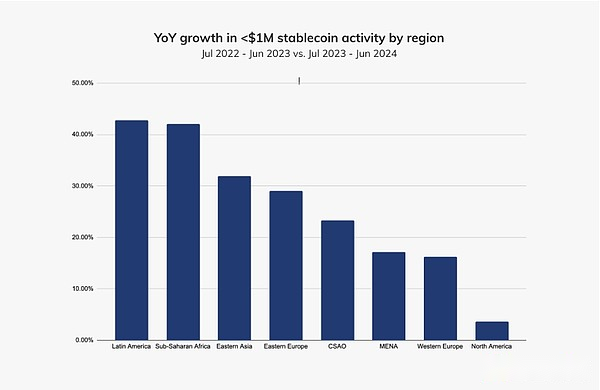
Latin America and Sub-Saharan Africa are the fastest growing regions for retail and professional-scale stablecoin transfers, with an increase of more than 40% year-on-year.East Asia and Eastern Europe followed closely with year-on-year growth of 32% and 29% respectively.
at the same time,Retail stablecoin activity in markets such as North America and Western Europe has grown significantly, but is slower, which may be due to strong local financial infrastructure.Although institutional investors in these regions are increasingly using stablecoins for liquidity management, settlement and entry into cryptocurrencies.It is worth noting that Western Europe is home to the world’s second largest merchant service market, with the UK leading the region with a year-on-year growth of 58.4%.Stablecoins dominate these services, consistently occupying 60-80% of the market share every quarter, as shown in the figure below.
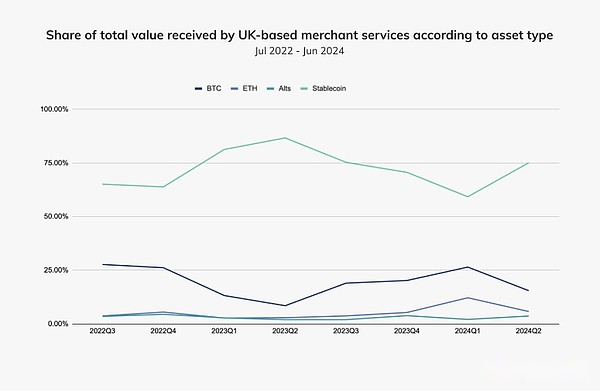
In the Middle East and North Africa, stablecoins and altcoins occupy a larger market share, surpassing traditional dominant assets such as BTC and ETH, especially in Turkey, Saudi Arabia and the UAE.
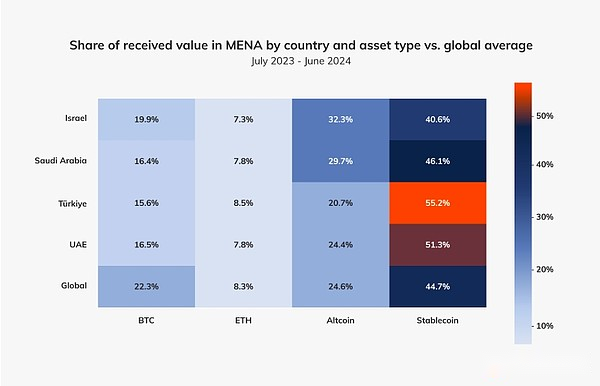
It is worth noting that Türkiye’s stablecoin trading volume accounts for a far ahead of the world’s GDP.
In East Asia, potential issuers have surged in interest in stablecoins after Hong Kong launched its stablecoin sandbox.The upcoming stablecoin regulation will pave the way for stablecoins to be listed in retail trading, which could boost Hong Kong’s web3 ambitions.
In Central and South Asia and Oceania, stablecoins are widely used in cross-border trade and remittances, bypassing the challenges of traditional banking.Countries such as Singapore have enhanced people’s confidence in stablecoins through regulatory frameworks, making stablecoins an important tool for retail investors and institutional users.
Global stable currency policy and regulation
Stablecoins have become a priority for global regulators as they are rapidly adopted in the global financial system and play an increasingly important role in a variety of use cases.Governments and regulators are working to address the challenges of creating a framework that encourages innovation, while ensuring consumer protection, financial stability, and compliance with anti-money laundering and Counter-Terrorism Financing (AML/CFT) standards.
EU (EU)
The EU (EU) has launched the Crypto Asset Market Supervision (MiCA), aiming to create a unified crypto asset framework for crypto asset issuers and service providers (including stablecoins) within the EU.MiCA represents a significant shift from anti-money laundering-focused regulation (introduced by the fifth anti-money laundering directive) to a comprehensive regulatory framework for prudent and behavioral obligations.MiCA focuses on strengthening consumer protection and ensuring market integrity and financial stability.MiCA’s stablecoin framework will take effect on June 30, 2024, and regulations governing cryptoasset Service Providers (CASPs) will take effect on December 20, 2024.While MiCA is a European regulation applicable to all 27 EU member states, the responsibility for licensing and overseeing issuers and CASPs lies with their respective national authorities.
MiCA has established two different types of stablecoins: (i) Asset Reference Tokens (ARTs), designed to maintain stable value by reference to another value or rights or a combination of both, including one or moreOfficial currency, commodities or crypto assets; (ii) Electronic currency tokens (EMTs), designed to maintain stable value by reference to the value of an official currency, such as the euro or the dollar.ART and EMT issuers within the EU must obtain the appropriate MiCA license, including the issuance of detailed white papers and comply with strict rules on governance, reserve asset management and redemption rights.
EMT (considered as both a crypto asset and a fund) is a means of payment, while ART is regarded as a means of trading that requires issuers to report trading activity in more detail.In addition, ART may be subject to issuance restrictions.The main stablecoins, the so-called “significant” stablecoins, face stricter regulation, including higher capital requirements and reserve asset obligations, are directly regulated by the European Banking Authority (EBA) rather than the national regulator.While MiCA has the potential to become a global standard, challenges such as unclear national implementation and overlapping classification remind people of the need for additional guidance to ensure smooth implementation and adoption.
Singapore
The Monetary Authority of Singapore (MAS) has completed the country’s stablecoin regulatory framework, focusing on single-currency stablecoins (SCS) pegged to the Singapore dollar or any G10 currency circulating in Singapore.The framework focuses on value stability, capital adequacy, redemption and disclosure to ensure prudent and robustness and consumer protection.Stablecoin issuers that meet all requirements of the framework can apply for being recognized as “MAS-regulated stablecoins”.
Hongkong
Hong Kong is a special administrative region of China and has a different legal and regulatory framework than mainland China.This separation allows Hong Kong to develop incremental regulatory policies around stablecoins and other crypto assets.The Hong Kong Monetary Authority (HKMA) has developed a regulatory framework for stablecoin issuers, acknowledging the rapid development of the digital currency landscape.Even as legislation is about to be completed, HKMA has launched a sandbox that enables industry stakeholders with compelling use cases to develop and test their business models, facilitating two-way discussions on regulation and risk management.In July 2024, three projects were included in the sandbox.
Japan
Japan is one of the first countries in the world to establish a stablecoin regulatory framework.The framework places great emphasis on stability and supervision, allowing banks, trust companies and fund transfer service providers to issue legally supported stablecoins under strict reserve requirements.Large companies such as Mitsubishi UFG are reportedly exploring stablecoin opportunities, but the market is still in its infancy, with no stablecoin listed on local exchanges or registered with electronic payment tools service providers (EPISPs).Recently, the Japan Financial Services Agency is reviewing stablecoin rules and considering international experience.
USA
The regulation of stablecoin in the United States is still in progress, and there is great uncertainty and controversy.While stablecoins such as USDC and USDT have been widely used in payments and financial services, the lack of a comprehensive regulatory framework presents challenges for both issuers and users.Measures to address this include proposed legislation, such as the Stablecoin Act proposed by the House Financial Services Committee in 2023, which aims to create clear rules for issuers regarding reserves, transparency, and anti-money laundering (AML) compliance.
Major stablecoin issuers
While there are hundreds of stablecoins currently in circulation, most are issued by Tether, followed by Circle.Although other issuers have a small market share, they are actively changing the stablecoin landscape.
Tether (UDST)
Tether (USDT) is the largest stablecoin calculated by market value, accounting for the vast majority of the stablecoin supply and providing liquidity to numerous blockchains.Tether’s reserves and financial transparency have been under scrutiny, but the company noted that audits and market stress testing have proved its solid position.Tether holds nearly $100 billion in Treasury bills, with most of its assets managed by Cantor Fitzgerald, making its reserve assets comparable to those of major countries.Tether continues to expand its product range to include UAE Dirham-backed tokens and gold-backed stablecoins, focusing on the market where these assets provide tangible value.
Circle (USDC)
Circle issues USDC, the second largest stablecoin by market capitalization.USDC is known for its transparency and proves its reserves weekly.Reserves are held in the form of cash and short-term U.S. government bonds, providing users with a high level of transparency and assurance.
Paxos
Paxos issues Pax Dollar (USDP) and provides infrastructure for PayPal’s stablecoin PayPal USD (PYUSD) and other stablecoin projects around the world.Paxos emphasizes transparency and trust, adheres to portfolio management guidelines and publishes monthly forensic reports to verify reserves.
PayPal (PYUSD)
PayPal has entered the stablecoin market through PayPal USD (PYUSD), issued in partnership with Paxos.Designed for payments, PYUSD is powered by reserves managed by Paxos and provides transparency reports to the public regularly.
Use cases for stablecoins
Once primarily used in cryptocurrency trading, stablecoins have become a versatile tool for everyday use cases, providing a wide range of usefulness to the cryptocurrency native ecosystem and TradFi.
Access to DeFi
Stablecoins are the backbone of many DeFi protocols that facilitate borrowing and earning farming.They have no price volatility and are ideal for liquidity pools, reducing impermanent losses and maintaining efficiency on decentralized exchanges (DEXs).Stablecoins can also enable global financial services, allowing users in economically unstable areas to participate in the DeFi market without having to withstand the impact of local currency fluctuations.
Payment and peer-to-peer (P2P) transactions
Stablecoins are increasingly used for daily payments and P2P transfers.Compared to traditional banking systems, they are able to process transactions quickly and cost-effectively, often with minimal fees, which is an attractive option for users.In P2P transactions, stablecoins provide individuals with a simple and secure way to exchange values without intermediaries.This is especially valuable in areas where reliable banking systems are not available.
Cross-border transactions and remittances
Cross-border payments and remittances are one of the most transformative use cases for stablecoins.They offer a faster and cheaper alternative than traditional remittance services, which often involve high fees and slow processing times.Immigrant workers (usually without or lacking banking services) use stablecoins to send money home, while businesses use them to settle international invoices.Stablecoins provide a solution that bypasses the inefficiency of traditional financial systems, enhances financial inclusion and reduces friction in cross-border transactions.
For example, remittances of $200 from sub-Saharan Africa using stablecoins are about 60% cheaper than traditional fiat-based remittance methods, as shown below.
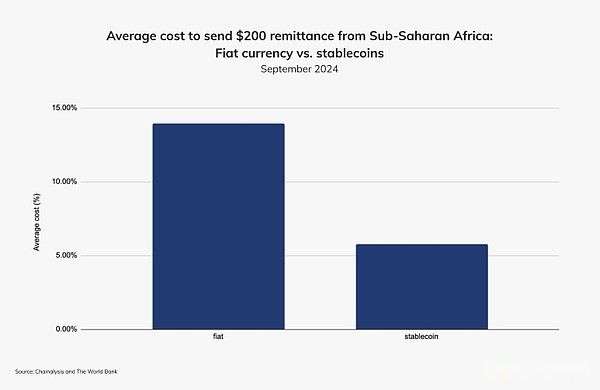
Forex (FX) and trade financing
For foreign exchange and trade financing, stablecoins enable businesses to trade in digital currencies that are accepted globally, reducing reliance on intermediaries and reducing risks associated with exchange rate fluctuations.Stablecoins simplify transactions between importers and exporters, providing a stable and transparent medium for international trade, especially in areas with limited foreign exchange access.
Store of value in economic instability or inflation
Stablecoins have become the preferred store of value in areas facing economic instability or high inflation.By pegging its value to assets such as the US dollar, stablecoins provide individuals and businesses with a way to maintain purchasing power and protect their assets from local currency fluctuations.This use case is especially effective in emerging markets, which have limited access to stable financial instruments and are highly desirable to go directly to the US dollar.
Stablecoins are usually traded at a premium in high inflation areas, reflecting users’ willingness to pay for stability and faster flow of capital.Currency instability in emerging markets can lead to substantial GDP losses over time, further driving demand for stablecoins.
Illegal Activities in Stablecoin Ecosystem
While stablecoins have gained significant attention for their legal use cases, they are also exploited by high-risk and illegal actors for various illegal activities.Their stability and global accessibility make them an attractive tool for trying to bypass financial controls and avoid found bad actors—although the inherent transparency and traceability of blockchains often make this a bad onechoice.
While we estimate that less than 1% of on-chain transactions are illegal, stablecoins have been used for activities such as money laundering, fraud and evasion of sanctions.Due to its relatively high liquidity and high acceptance on cryptocurrency exchanges, stablecoins can be used to quickly transfer value across borders without relying on traditional financial institutions.
Use stablecoins to evade sanctions
As countries such as Russia explore alternatives to bypass Western financial restrictions, evading sanctions through stablecoins and other cryptocurrencies is becoming increasingly prominent.Entities in sanctioned areas may use stablecoins to promote international trade or transfer funds to entities in sanctioned jurisdictions.These activities use the anonymous nature of blockchain transactions to mask the source of funds, often through complex networks of wallets and exchanges.Although large-scale sanctions evasion remains challenging due to cryptocurrency market liquidity restrictions and transparency in blockchain transactions, smaller-scale activities such as transfers of funds from sanctioned entities and political public figures will lead to security and harmony.Regulate risks.
How stablecoin issuers work with law enforcement
Stablecoin issuers have stepped up their efforts to combat financial crimes and support global law enforcement and regulatory investigations.Issuers such as Tether work closely with regulators such as the Global Law Enforcement Agency, Financial Crime Unit and Financial Crime Enforcement Network (FinCEN) to use Chainalysis to monitor transactions in real time and identify suspicious activity.Most centralized stablecoin issuers also have the power to freeze or permanently delete or “destroy” tokens in wallets associated with confirmed criminal activity, thereby preventing illegal transactions and helping to recover stolen funds.
Which stablecoin issuers can destroy and freeze tokens?
Stable coins issued by centralized services, such as USDC (Circle), USDT (Tether), BUSD (Paxos) and TUSD (Techteryx), can be frozen or destroyed by their issuers to comply with regulations or prevent illegal activities.In contrast, decentralized stablecoins, such as DAI (MakerDAO), FRAX (Frax Finance) and LUSD (Liquity), are managed by protocols and smart contracts, and are therefore not frozen or destroyed by any centralized institutions.The balance between compliance and user autonomy is an important consideration for decentralized technology.
The future of stablecoins
Stablecoins not only represent a critical intersection between blockchain and traditional financial systems, but also open up new avenues for economic participation.Adoption rates across regions and industries continue to grow, supported by regulatory advances designed to provide clarity and build trust between users and institutions.As frameworks such as MiCA in Europe and guidelines for markets such as Singapore and Japan take shape, stablecoins will gain further legitimacy and integrate into the mainstream financial system.
The future of stablecoins is not without challenges.Problems of regulatory uncertainty in major markets, exploitation of illegal actors, and transparency in reserves are always present, and if not addressed effectively, these issues could undermine market confidence and hinder wider adoption.On the other hand, stablecoins provide huge opportunities for financial inclusion, especially in underserved areas, and are actively innovating payments, remittances and trade financing by reducing costs and increasing rates.The role of stablecoins in creating new financial products and simplifying cross-border trade further illustrates their potential for change.
With the continuous advancement of regulation and technology, stablecoins have the potential to unlock new opportunities, narrow the gap between economies and achieve greater global financial connectivity.Their continued development will play a central role in defining the future of cryptocurrencies and TradFi.

